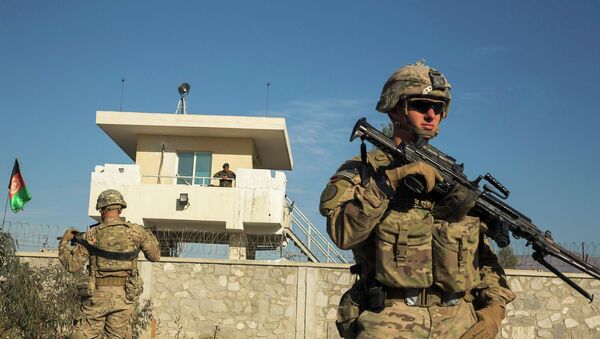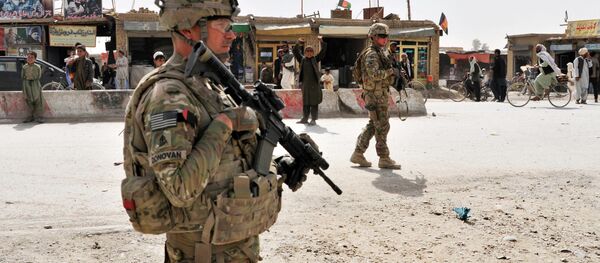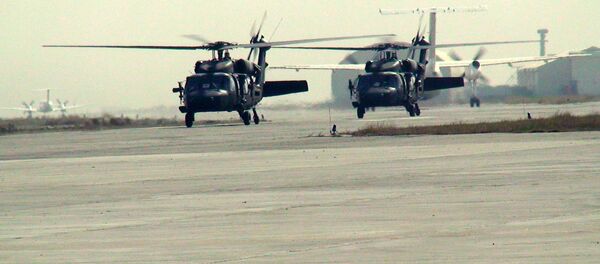“That is the longest war in American history and apparently it is not going to end now,” professor of history at the University of Arizona David Gibbs told Sputnik commenting on NATO’s Resolute Support mission which is due to be launched on January 1. “So I don’t really think there is any strategy or game plan, other than save face politically, that is the main objective here. As for the US foreign policy objective, for President Obama in particular, it is to not be seen as a president who invited a military defeat.”
On Sunday, NATO-led forces in Afghanistan formally ended their military engagement, holding a ceremony at their military headquarters in Kabul. However, the alliance’s Resolute Support mission will soon replace the International Security Assistance Force (ISAF), created in the aftermath of the 9/11 terrorist attacks in the US to tackle insurgency in Afghanistan.
Resolute Support is described as a non-combat NATO-led mission, which will be tasked with training and mentoring Afghan National Security Forces (ANSF).
Chris Mason, a professor of National Security Affairs at the US Army War College’s Strategic Studies Institute, explained that not much has changed with regard to US plans for the size of its contingent in Afghanistan. However, what has changed is President Obama’s commitment to maintain an additional 1,000 U.S. combat forces in Afghanistan in addition to the 9,000 non-combat personnel involved in Resolute Support.
“I believe these additional forces will be almost exclusively engaged in Close Air Support (CAS), both flying and maintaining the aircraft required and the ground elements to operate with Afghan forces to call in the air strikes. Because of the language barrier, this has to be done in English, as American pilots can't speak Dari. The Afghan National Air Force (ANAF) has no capability to conduct CAS,” Mason, who served as a political officer on the Pakistan-Afghanistan border and recently retired from the US Foreign Service, told Sputnik.
He also underlined that the need to maintain this capability in Afghanistan in 2015 was realized during the fighting this year, as it became clear that the Afghan National Army (ANA) garrisons in several cases would have been overrun by the Taliban without American CAS. However, the reliance on CAS on the part of the ANA is largely a problem created by the United States in training and operating with the ANA in the field.
David Gibbs also sees the root cause of the troubles in Afghanistan in the US’ military involvement in the country, even though Afghanistan has been dysfunctional since the revolution of 1978.
“Ironically and perhaps regrettably, the most stable period Afghanistan has seen was actually under the Taliban. It was a relatively stable period when the level of fighting was low and one of the mistakes the US made was overthrowing the Taliban,” Gibbs said adding that things worsened after Washington overthrew the Taliban, so that there is nothing on the horizon now which suggests that there will be stability in Afghanistan.
He also pointed out that, to date, the United States has been very efficient in creating national security threats.
So it appears to be a vicious circle here, with more Western military involvement in Afghanistan creating even more threats that require even more intervention, which in turn multiplies the threat to national security.
At the same time, Fahim Masoud who used to work as a linguist and cultural adviser for the United States Army in Afghanistan believes that NATO’s stay will help to stabilize the situation in Afghanistan, as the country is plagued by many uncertainties.
“The Afghans I talked to did not want NATO to pull out so soon because Afghanistan's armed forces are still not in a position to offset insurgents' attacks and provide stability throughout the provinces,” Masoud told Sputnik, adding that the NATO mission will help train more Afghan troops, as well as create employment. “The presence of 12,000 troops will boost the Afghan economy as it will create employment for many local Afghans.”
The ISAF was 140,000 troops strong at its peak, according to Associate Press. The death toll of the mission reached 3,500, with 2,224 US soldiers killed since 2001.





